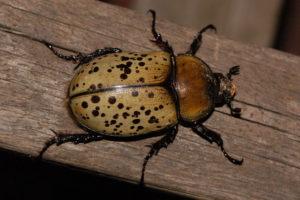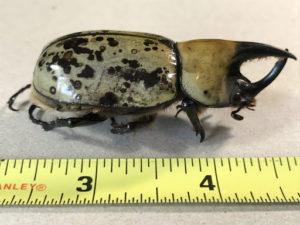Eastern Hercules beetle, a part of the scarab beetles family, and rhinoceros beetle subfamily occupy certain parts of the United States. Becol3s being called the eastern Hercules beetle, its other common names include the ox beetle and elephant beetle. Carl Linnaeus, the famous Swedish botanist, initially assigned the scientific name Scarabaeus tityus, later changed to Dynastes tityus.
Size: 20 – 27 mm (0.8 – 1.1 inches) wide in both sexes; Approximately 60 mm (2.4 inches) in males; females appear shorter
Color: They have a tan, green, and gray elytra with black spots resembling a mottled pattern. However, the pattern or marks on their body varies from one species to the other. For instance, those found in rotten wood or soil have a dark body with blurred spots.
Other Characteristic Features: One striking physical feature is the large horns primarily seen in males but absent in females. In fact, of the two horns, one project from their thorax, and the other from their head.


The C-shaped larva has a grub-like appearance, having a white body alongcol3 mouthparts. They mainly inhabit decayed wood, excreting rectangular-shaped fecal pellets with a length of approximately 10 mm.
The larva enters the pupal phase during late summer. Upon maturation, the adults remain encased within the pupal cell the whole of winter, after which they emerge.
The eggs are round and laid in the soil.
| Other Names | Ox beetle, elephant beetle |
| Adult lifespan | 6 -8 months |
| Duration of larval stage | 6 – 12 months |
| Distribution | Eastern and southeastern parts of United States covering parts of New York, Indiana, Illinois, Florida, Gulf of Mexico, and eastern Texas |
| Habitat | In forests, mostly on decayed trees and rotten wood |
| Common predators | Eggs – predatory mite Grubs or larva – Mammals like raccoon and skunks; ground beetles, spiders, and centipedes |
| Seasons active from | Not recorded |
| Host plants | Ash trees |
| Diet of larvae and adults | Larvae: Decayed root Adults: Mostly saps of their host plants |
They feed on the decayed roots, but reports of any significant damage caused by the larva and adults remain unknown.
Image Source: zoosafariusa.org, lh3.googleusercontent.com, discoverlife.org, roadsendnaturalist.files.wordpress.com, arthurevans.files.wordpress.com, upload.wikimedia.org, i.pinimg.com
Eastern Hercules beetle, a part of the scarab beetles family, and rhinoceros beetle subfamily occupy certain parts of the United States. Becol3s being called the eastern Hercules beetle, its other common names include the ox beetle and elephant beetle. Carl Linnaeus, the famous Swedish botanist, initially assigned the scientific name Scarabaeus tityus, later changed to Dynastes tityus.
Size: 20 – 27 mm (0.8 – 1.1 inches) wide in both sexes; Approximately 60 mm (2.4 inches) in males; females appear shorter
Color: They have a tan, green, and gray elytra with black spots resembling a mottled pattern. However, the pattern or marks on their body varies from one species to the other. For instance, those found in rotten wood or soil have a dark body with blurred spots.
Other Characteristic Features: One striking physical feature is the large horns primarily seen in males but absent in females. In fact, of the two horns, one project from their thorax, and the other from their head.


The C-shaped larva has a grub-like appearance, having a white body alongcol3 mouthparts. They mainly inhabit decayed wood, excreting rectangular-shaped fecal pellets with a length of approximately 10 mm.
The larva enters the pupal phase during late summer. Upon maturation, the adults remain encased within the pupal cell the whole of winter, after which they emerge.
The eggs are round and laid in the soil.
| Other Names | Ox beetle, elephant beetle |
| Adult lifespan | 6 -8 months |
| Duration of larval stage | 6 – 12 months |
| Distribution | Eastern and southeastern parts of United States covering parts of New York, Indiana, Illinois, Florida, Gulf of Mexico, and eastern Texas |
| Habitat | In forests, mostly on decayed trees and rotten wood |
| Common predators | Eggs – predatory mite Grubs or larva – Mammals like raccoon and skunks; ground beetles, spiders, and centipedes |
| Seasons active from | Not recorded |
| Host plants | Ash trees |
| Diet of larvae and adults | Larvae: Decayed root Adults: Mostly saps of their host plants |
They feed on the decayed roots, but reports of any significant damage caused by the larva and adults remain unknown.
Image Source: zoosafariusa.org, lh3.googleusercontent.com, discoverlife.org, roadsendnaturalist.files.wordpress.com, arthurevans.files.wordpress.com, upload.wikimedia.org, i.pinimg.com